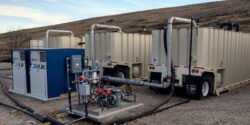San Jose-Santa Clara Regional Wastewater Facility

The San Jose-Santa Clara Regional Wastewater Facility, also known as the San Jose-Santa Clara Water Pollution Control Plant, is a state-of-the-art wastewater treatment facility located in the heart of Silicon Valley. Serving the cities of San Jose, Santa Clara, Milpitas, Sunnyvale, Campbell, and Cupertino, the facility plays a crucial role in protecting public health and the environment by treating wastewater before it is discharged into the San Francisco Bay.
History of the San Jose-Santa Clara Regional Wastewater Facility
The San Jose-Santa Clara Regional Wastewater Facility has a long history dating back to the early 1950s when it was first established to address the growing population and urban development in the region. Over the years, the facility has undergone several upgrades and expansions to keep up with the increasing wastewater volumes and stricter environmental regulations.
The facility is currently owned and operated by the City of San Jose in partnership with the City of Santa Clara. It is one of the largest wastewater treatment plants in California, serving a population of over 1.4 million residents. The facility has a design capacity of 167 million gallons per day (MGD) and treats an average of 110 MGD of wastewater on a daily basis.
Treatment Process
The San Jose-Santa Clara Regional Wastewater Facility uses a multi-step treatment process to remove contaminants from the wastewater before it is discharged into the Bay. The process includes the following steps:
1. Preliminary Treatment: The wastewater enters the facility through a network of pipes and is screened to remove large debris such as sticks, rags, and plastics. The screened wastewater then undergoes grit removal to separate sand, gravel, and other heavy particles.
2. Primary Treatment: In this step, the wastewater is settled in large tanks to allow solids to settle at the bottom and oils and greases to float to the surface. The settled solids, known as primary sludge, are then removed and sent to the digesters for further treatment.
3. Secondary Treatment: The secondary treatment process involves biological treatment to remove organic matter and nutrients from the wastewater. The wastewater is aerated in large tanks where microorganisms break down organic matter into carbon dioxide, water, and biomass. The treated wastewater, known as secondary effluent, is then sent to clarifiers to settle out the remaining solids.
4. Tertiary Treatment: In some cases, the facility may employ tertiary treatment to further polish the wastewater before discharging it into the Bay. This may include advanced filtration, disinfection, and nutrient removal to meet strict water quality standards.
Environmental Benefits
The San Jose-Santa Clara Regional Wastewater Facility plays a vital role in protecting the environment and public health. By treating wastewater before it is discharged into the Bay, the facility helps prevent water pollution, reduce the risk of waterborne diseases, and protect aquatic ecosystems. The treated effluent also helps replenish groundwater supplies and support wildlife habitats in the Bay Area.
In addition to treating wastewater, the facility is also committed to sustainable practices and resource recovery. The facility generates biogas from the digestion of sludge, which is used to produce electricity and heat for on-site operations. The biosolids produced during treatment are recycled as a soil amendment for agriculture and landscaping, reducing the need for chemical fertilizers.
Future Plans and Upgrades
As the population in Silicon Valley continues to grow, the San Jose-Santa Clara Regional Wastewater Facility is facing the challenge of increasing wastewater volumes and stricter regulatory requirements. To address these challenges, the facility is planning for future upgrades and expansions to enhance its treatment capacity and efficiency.
One of the key initiatives underway at the facility is the implementation of advanced treatment technologies to improve the quality of treated effluent. This includes the use of membrane bioreactors, UV disinfection, and nutrient removal processes to meet the stringent water quality standards set by regulatory agencies.
Another focus area for the facility is the optimization of energy usage and resource recovery. By investing in energy-efficient technologies and renewable energy sources, the facility aims to reduce its carbon footprint and operational costs. The facility is also exploring opportunities for recovering valuable resources from wastewater, such as phosphorus and nitrogen, for use in sustainable agriculture and industry.
Community Engagement and Education
The San Jose-Santa Clara Regional Wastewater Facility actively engages with the local community to raise awareness about the importance of wastewater treatment and environmental stewardship. The facility offers tours, workshops, and educational programs for students, teachers, and community groups to learn about the treatment process and the role of the facility in protecting public health and the environment.
Additionally, the facility partners with local schools, universities, and nonprofit organizations to promote water conservation, pollution prevention, and sustainable practices. By working collaboratively with the community, the facility aims to foster a culture of environmental responsibility and inspire future generations to become advocates for clean water and healthy ecosystems.
Conclusion
The San Jose-Santa Clara Regional Wastewater Facility is a vital asset in Silicon Valley’s infrastructure, providing essential services for the treatment of wastewater and the protection of public health and the environment. Through its innovative treatment processes, sustainable practices, and community engagement efforts, the facility is leading the way in wastewater management and resource recovery.
As the region continues to grow and evolve, the San Jose-Santa Clara Regional Wastewater Facility remains committed to meeting the challenges of the future and ensuring a sustainable water supply for generations to come. By investing in advanced technologies, conservation practices, and public outreach initiatives, the facility is setting a high standard for wastewater treatment and environmental stewardship in the Bay Area.
Sources:
1. https://www.sanjoseca.gov/Home/Components/FacilityDirectory/FacilityDirectory/373/2136
2. https://www.valleywater.org/environmental-authority/water-pollution-control-plant


